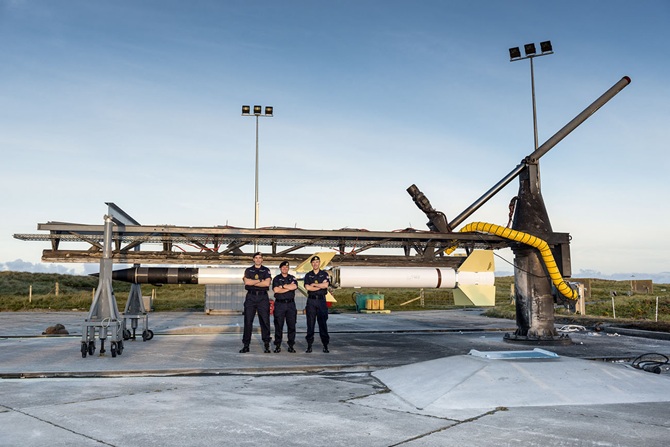Members of the Maritime Theatre Missile Defence (MTMD) Forum used Exercise Joint Warrior to carry out a number of operationally realistic test serials prior to the shooting down of a ballistic missile.
At Sea Demonstration 15 (ASD15) was the culmination of years of planning and its main event, one of over 30, saw the simultaneous tracking and engagement of an ultra-high altitude missile as well as two sea skimming cruise missiles.
For the 10 member states making up the MTMD, it was a demonstration of how joint working between some of the best navies in the world has moved to the next level of cooperation with ships taking part sharing information simultaneously to stations in the UK, USA, Canada, France, Italy, Norway and Spain while under the command of a Dutch Commodore aboard HNLMS De Zeven Provincien.
The Type 45 Destroyer, HMS Dauntless, represented the Royal Navy building on previous successful multi-national cooperation, particularly in the Middle East.
Due to the sheer scale of the exercise on the QinetiQ operated range, all transatlantic air routes north west of the UK were closed from sea level to the edge of space during the live firing events.
Captain Steve Holt, Captain Martime Warfare Centre, joined the ASD team to lead the QinetiQ and MTMD trials execution team at the Range.
Responsible for the safe delivery of the most complex live firing serials ever attempted in the UK, he worked closely with the Dutch Commander of the Task Group to integrate target delivery with the operational challenges of the Atlantic in October.
Capt Holt said: “ASD15 has been one of the most rewarding tasks I have done in 32 years in the Royal Navy and in particular the demonstration of a warfighting capability never achieved before. Of all the firsts we achieved, the one that means most to me was launching the first ballistic rocket to enter space from the UK.
“ASD15 has created opportunities to develop doctrine, tactics and procedures to enhance the RN’s warfighting capabilities against current and future threats.”
Commander Mark Williams, who has been working towards ASD15 for the past two years said the event was also an investigation into multi-national working.
“Nations traditionally purchase bespoke systems which are not necessarily interoperable. ASD15 was about allowing one bespoke system to pass information to another maintaining data quality and accuracy,” he said.
“We have never done a demonstration on this level before. In terms of types of network, both for line of sight and beyond line of sight. But also breadth, from sea level to space and in intensity of operations.”
Although the Royal Navy has no Ballistic Missile Defence (BMD) capability, the UK has been closely involved BMD technology research for many decades.
In 2004 the UK joined the Maritime Theatre Missile Defence Forum (MTMD) and today the UK participation forms an important part of the Royal Navy’s drive towards full interoperability with potential partner nations.
The Forum’s goal is to attain an information sharing network between units at sea to enable protection against the proliferation of short, medium and long range ballistic missiles and advanced anti-ship cruise missile threats.
It does so through a series of international projects like ASD15.
Weapons Engineering Officer Lieutenant Commander Ben Kadinopoulos was the Test Director for the ASD15 serials as well as leading the Forum’s planning team.
He also worked with colleagues from the Joint Tactical Exercise Planning Staff, who provided air tasking and logistics support.
Lt Cdr Kadinopoulos added: “The success in delivering Europe’s most complicated naval weapons firing ever and the world’s first multinational integrated air and missile defence test has captured the attention of senior naval officers globally.
“There is a realisation of what capability enhancements can deliver following this trial. This is not just the sensors on the Type 45, but in terms of the interoperability of the networks we have created for ASD15, which remain effective for future tests and operations.”
Image Sourced: Royal Navy

